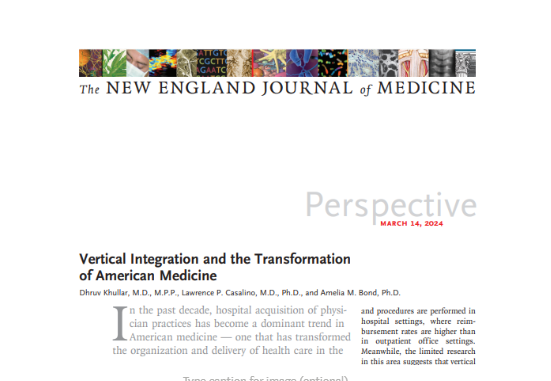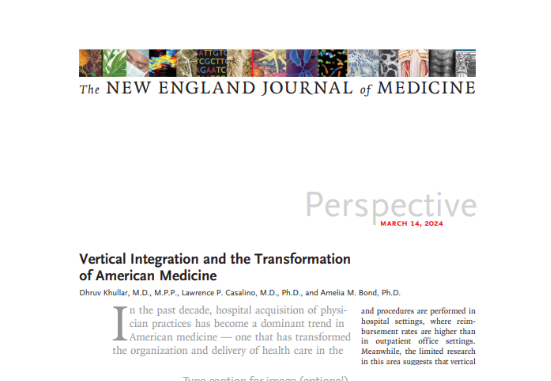the health
transformation
knowledge portal
Joaquim Cardoso MSc
Founder and Chief Researcher, Editor & Strategist
March 9, 2024
What is the Message?
The article discusses the impact of vertical integration — the merging of organizations operating at different levels of production — on American medicine.
Specifically, it focuses on the acquisition of physician practices by hospitals and its effects on health care delivery, quality, and costs in the United States.

This is an Executive Summary of the paper “Vertical Integration and the Transformation of American Medicine”, published by NEJM, witten by
Dhruv Khullar, M.D., M.P.P., Lawrence P. Casalino, M.D., Ph.D., and Amelia M. Bond, Ph.D.,on March 9, 2024
Key Findings and Statistics:
Trend in Hospital Ownership:
- Between July 2012 and January 2018, the proportion of practices owned by hospitals increased from 14% to 31%.
- Subsequently, from January 2019 to January 2022, hospitals acquired an additional 4800 practices, leading to about 58,000 more physicians becoming hospital employees.
Impact on Health Care:
- The quality and cost of U.S. health care are increasingly tied to the success or failure of hospital-owned practices.
- More patients now receive care from hospital-employed physicians.
Theoretical Benefits of Vertical Integration:
- Improved patient outcomes through care coordination, information exchange, and economies of scale.
Documented Effects:
- Price Increase: Vertical integration has consistently led to higher prices. Integrated hospitals and physician practices negotiate from a stronger position compared to commercial insurers.
- Research suggests that Medicare pays, on average, 43% more for common oncologic and cardiac services when they are delivered in a hospital setting and that nearly half of the increase in commercial prices after a practice is acquired by a hospital can be attributed to a shift in the site of service delivery.
- Facility Fees: Hospital-owned practices often add “facility fees” to services, contributing to cost escalation.
Impact on Public Payers:
- Even for public payers (where prices are administratively fixed), vertical integration can increase spending. Referral and utilization patterns shift toward hospital settings with higher reimbursement rates.
Conclusions and Recommendations:
Hospital acquisitions of physician practices have gone largely unreviewed by agencies such as the Federal Trade Commission (FTC) and the Department of Justice (DOJ), in part because most acquisitions don’t reach the minimum financial threshold for reporting to the federal government ($119.5 million in 2024).
Caution in Vertical Integration: Policymakers and health care leaders should exercise caution when considering vertical integration. While potential benefits exist, the documented price increases warrant scrutiny.
Balancing Quality and Costs: Striking a balance between improved coordination and cost containment is crucial. Transparent pricing and monitoring of outcomes are essential.
Policy Implications: Policymakers should explore regulatory measures to mitigate price escalation while preserving the potential advantages of vertical integration.
To summarize, vertical integration in American medicine has reshaped health care delivery, but its impact on costs requires careful management.
Balancing quality, cost, and patient outcomes remains a critical challenge for the future of health care in the United States








